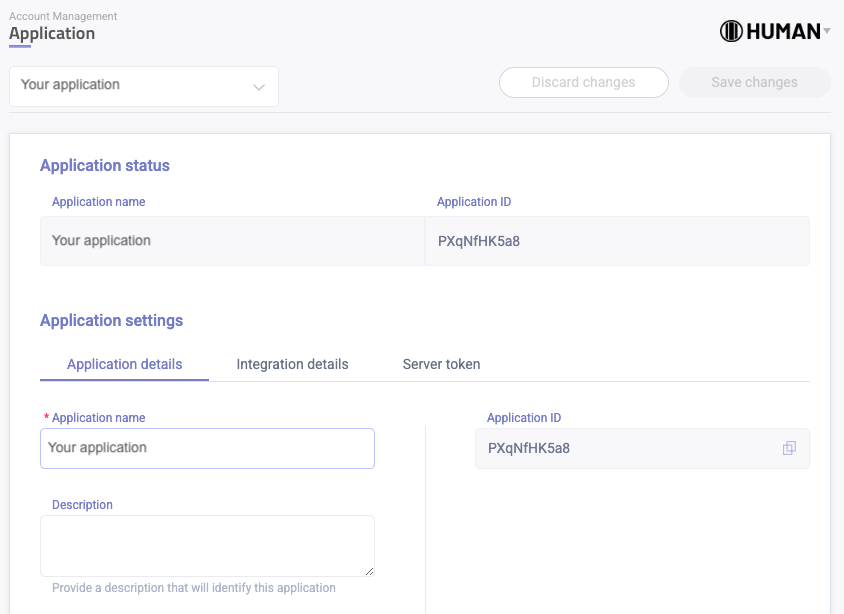Setting up your Application
After creating a new application, you can change its default settings.
- Go to Platform Settings > Applications > Overview.

- Select the required application. The Application screen opens.

Updating Application Details
Under Application details, you can change the application name and add a description that will help you identify this application.
The application ID is assigned automatically and cannot be changed.
Updating Integration Details
Under Integration details, you can update the JavaScript Snippet before deploying it to your application.
The Snippet is a small section of JavaScript that activates HUMAN Sensor for your application. It is automatically generated and contains all the required code to make the Sensor work.
Depending on your preferences, you can switch between the Third-party Sensor and First-party Sensor.
After selecting the appropriate Sensor, you must deploy (copy and paste) the Snippet to all pages of your application.

Switching to the First-party Sensor
Where the Sensor is served locally from your domain, we recommend using the First-party Sensor.
The following Enforcer versions support First-party configuration:
- .NET v2.5.0 and higher
- Apache Core v0.10.0 and higher
- AWS Lambda v1.3.0 and higher
- Citrix v1.0 and higher
- Cloudflare v1.1.0 and higher
- Envoy Core v0.10.0 and higher
- F5 BIG-IP v2.3.0 and higher
- Fastly VCL v2.7.0 and higher
- Go v2.0.0 and higher
- Java v5.0.0 and higher
- Kong v1.2.0 and higher
- NodeJS v1.1.0 and higher
- NGINX Lua v3.1.0 and higher
- NGINX Core v0.10.0 and higher
- PHP v3.10.0 and higher
- Python v2.0.0 and higher
- Salesforce v18.2.1 and higher (no XHR support)
- Varnish v0.10.0 and higher
For certain Edge Enforcers, such as Fastly, the Sensor sends the First-Party XHR by default
The First-Party Sensor provides the following benefits:
- Improved performance - Serving the Sensor as part of the standard site content removes the need to open a new connection to HUMAN servers when a page is loaded.
- Improved detection - Third-party content may be blocked by certain browser plugins and privacy add-ons. The First-Party sensor leads directly to improved detection, as seen with customers who previously moved from the Third-party Sensor to the First-party Sensor.
TO switch to the First-party Sensor:
- Make sure your HUMAN Enforcer supports the First-party Sensor.
- Click Change to 1st Party Integrations.
- Follow the on-screen instructions.
Switching to the Third-party Sensor
By default, a new application is set to use the Third-party Sensor. The Third-party Sensor does not have prerequisites for deployment, but it lacks the advantages of the First-party Sensor.
TO switch to the Third-party Sensor:
- Click Change to 3rd Party Integrations.
- Follow the on-screen instructions.
Deploying the Snippet to your Application
TO deploy the Snippet:
- In the Snippet window, click Copy.
- Paste the snippet into your application pages using your preferred method (tag manager, header manager, etc). Best practice is to place the snippet right before the open tag in the HTML. Dashboard statistics start accumulating as page views immediately upon saving the site pages with the snippet.
Adding Server Tokens
Server tokens identify your server when using API calls between your server and the HUMAN server. You can add up to three tokens.
TO add a token:
- Under Server token, click Add server token.
